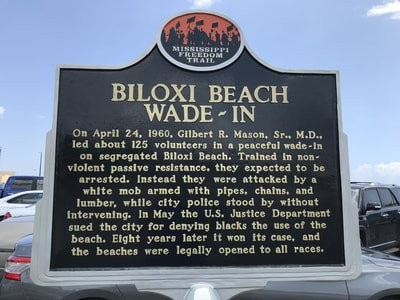Biloxi Beach Wade-In Historical Marker (Bloody Sunday)
Introduction
Text-to-speech Audio
Images
The marker was dedicated in 2009 and is in the parking lot by the beach.

Backstory and Context
Text-to-speech Audio
A historical marker was unveiled in 2009 to honor the Biloxi Wade-Ins also known as “Bloody Sunday.” In 1960 Biloxi’s twenty-six mile Gulf of Mexico shoreline was segregated. Frustrated by the segregated shoreline, African American residents protested their exclusion from the public shoreline.
There were a total of three wade-in protests. The first protest occurred on May 14, 1959, when nine people held a public protest with a purpose of seeing how the police would respond. The second wade-in was a solitary protest by one African American citizen, Dr. Mason. Although he was well-known and respected whites refused to allow Dr. Mason to use the beach.
The protest commemorated by this marker and known as “Bloody Sunday” took place on Easter Sunday in 1960. Led by physician Gilbert Mason, the Black community sought to rectify restricted access by enacting a series of “wade-in” protests. Chaos and violence, though, quickly marred this particular demonstration.
